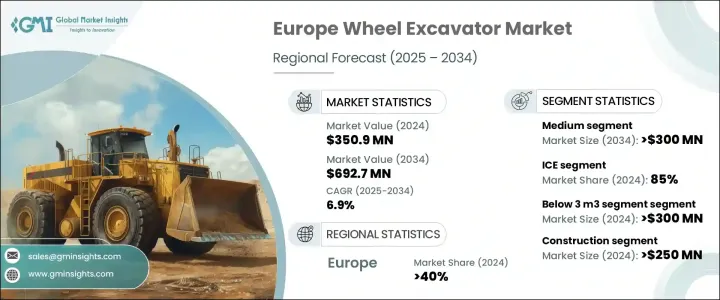PUBLISHER: Global Market Insights Inc. | PRODUCT CODE: 1721459

PUBLISHER: Global Market Insights Inc. | PRODUCT CODE: 1721459
Europe Wheel Excavator Market Opportunity, Growth Drivers, Industry Trend Analysis, and Forecast 2025 - 2034
Europe Wheel Excavator Market was valued at USD 350.9 million in 2024 and is estimated to grow at a CAGR of 6.9% to reach USD 692.7 million by 2034. This upward trajectory stems from the growing need for adaptable and efficient construction equipment amid Europe's rising urbanization and infrastructure projects. As urban areas across the region continue to expand, there's an increasing demand for compact, agile machinery capable of operating in constrained environments without sacrificing performance. Wheel excavators offer this flexibility, making them ideal for urban construction, roadwork, and utility projects. Additionally, the European construction industry is undergoing a transformative shift toward sustainability, driven by stringent environmental regulations and carbon reduction goals. Contractors and developers are now seeking advanced machines that not only deliver operational efficiency but also align with evolving emissions standards. In this landscape, manufacturers are focusing on innovations in energy efficiency, electric mobility, and intelligent controls to appeal to environmentally conscious buyers. The adoption of hybrid and electric wheel excavators is also gaining momentum as companies prioritize green technologies to future-proof their operations and stay compliant with EU climate mandates.

The demand for medium-sized wheel excavators is also gaining significant traction across Europe. These excavators generated USD 140 million in 2024 and are projected to reach USD 300 million by 2034. Their popularity is largely attributed to their ideal balance between power and maneuverability, making them suitable for a broad spectrum of applications-from civil infrastructure to residential development. In addition to their practical size, these models are increasingly available in electric and hybrid variants, reflecting the region's heightened focus on reducing environmental impact. Mini and compact excavators are further driving market momentum, as they produce fewer emissions and offer lower fuel consumption, directly supporting Europe's sustainability objectives. With stricter emission regulations now in place, the shift toward eco-friendly equipment is becoming more than a trend-it's a necessity.
| Market Scope | |
|---|---|
| Start Year | 2024 |
| Forecast Year | 2025-2034 |
| Start Value | |
Table of Contents
Chapter 1 Methodology & Scope
- 1.1 Research design
- 1.1.1 Research approach
- 1.1.2 Data collection methods
- 1.2 Base estimates and calculations
- 1.2.1 Base year calculation
- 1.2.2 Key trends for market estimates
- 1.3 Forecast model
- 1.4 Primary research & validation
Chapter 2 Executive Summary
Chapter 3 Industry Insights
Chapter 4 Competitive Landscape, 2024
Chapter 5 Market Estimates & Forecast, By Product, 2021 - 2034 ($Bn, Units)
Chapter 6 Market Estimates & Forecast, By Bucket Capacity, 2021 - 2034 ($Bn, Units)
Chapter 7 Market Estimates & Forecast, By Propulsion, 2021 - 2034 ($Bn, Units)
Chapter 8 Market Estimates & Forecast, By Application, 2021 - 2034 ($Bn, Units)
Chapter 9 Market Estimates & Forecast, By Region, 2021 - 2034 ($Bn, Units)
Chapter 10 Company Profiles




